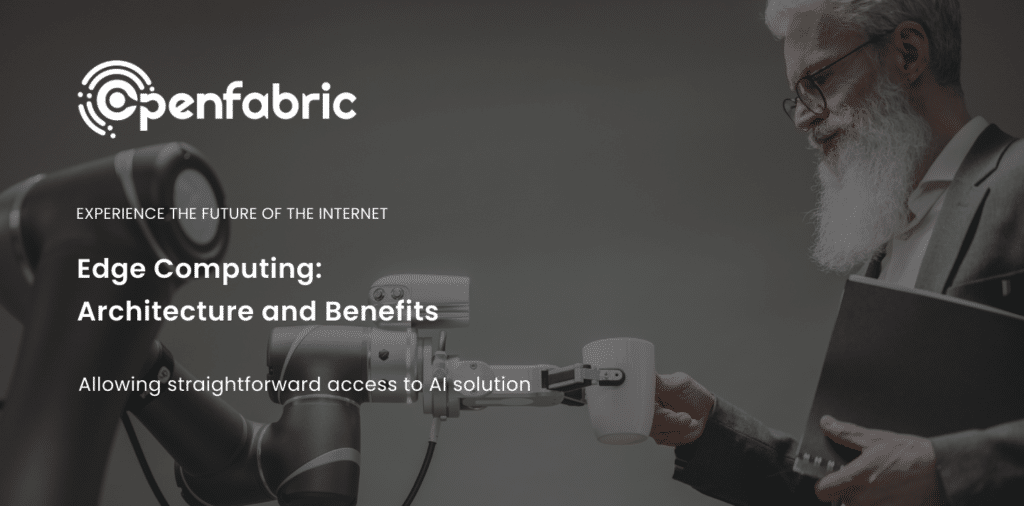
May 29, 2023 5 minutes read
Edge Computing Architecture and its Benefits

Edge Computing: A Smart Solution for Real-Time Data Processing
Innovative technology is transforming how we process data delivering unprecedented efficiency and performance. One such technology is Edge computing – a distributed computing paradigm designed to provide processing and storage capacity as close as possible to where it is needed most – right at the edge! As analyzed by Grand View Research, this approach has captured significant market attention with global worth estimates of over USD 3.5 billion in 2020, expected to grow impressively by 37.4% from 2021 to 2028! This growth can be attributed primarily to the mounting demand for IoT devices that generate increasing data requiring real-time analysis.
But how does edge computing work? We provided detailed information on how edge computing works as you read further. Meanwhile, instead of relying entirely on a centralized server Edge Computing performs operations locally using an edge server closer to where the data is generated. With reduced long-distance communication among clients and servers—cloud-based processes become obsolete- providing more localized computation power and direct access to efficient algorithms like machine learning (ML) or deep learning (DL). The explosive increase in data generated by IoT devices requires advanced processing techniques.
Machine Learning and Deep Learning algorithms have revolutionized how we handle this task by enabling real-time processing at the edge through innovative Edge AI applications. These applications facilitate data storage, analysis, sorting, and forwarding from Edge nodes to cloud systems for additional analysis, integration with IT apps, or other purposes.
Edge Computing Plus AI Equal Edge AI
Edge Artificial Intelligence (AI) allows algorithms to be run on a hardware device near the user through edge computing. This allows for faster real-time analysis and faster response times than cloud-based AI solutions. The AI algorithms process data generated on the device without any connection needed. It allows us to process data with the system in less than a few milliseconds, giving real-time information. We need a computer consisting of a microprocessor and sensors to use Edge AI.
Edge AI will allow real-time operations where milliseconds matter, including data creation, decision, and action. Real-time services are critical for self-driving cars, robots, and many other fields. A report from MarketsandMarkets reveals that the global edge AI Software market size is predicted to surge from USD 470 million in 2020 to USD 1,152 million by 2026, with a CAGR of 16.5%. This reflects a huge growth potential for this sector in the coming years. The rapid expansion of IoT devices has spurred the uptake of real-time data analysis and consequently led to a surge in growth..
Edge AI will reduce data communication costs because there will be fewer data transmissions. According to a report by Cisco, by 2022, By the end of 2020, the amount of data created by IoT devices is expected to skyrocket to 847 zettabytes per year – a massive increase from 218 zettabytes in 2018. This growth will increase the need for more efficient and cost-effective ways of processing and transmitting data, making Edge AI an increasingly important technology. The algorithms work based on the use of computer-generated data. But because neural networks fuel most AI systems today, much computing power is needed to run these systems at the Edge.
The challenge in meeting the AI inference performance requirements is ensuring algorithms’ high precision efficiency within low power consumption. But the advancement in hardware choices, including graphics processing units (GPUs), central processing units (CPUs), application-specific built-in circuits (ASICs), and system-on-a-chip (SoC) accelerators, has made Edge AI possible.
Requirements for Industrial Automation and Edge AI demand that decisions be taken in real-time. Data analytics must, therefore, be conducted at the Edge to provide immediate answers to critical issues. The IoT Edge platform
How does Edge AI work?
Before wrapping up this blog post, let’s talk about Edge A.I.! Picture this: data centers are like clustered servers – huge and located where the cost of real estate and electricity is lower. But there’s a problem – data can’t travel faster than the speed of light, even on the fastest fiber-optic networks. So what happens when there’s a physical gap between the data and the data centers? That’s where Edge A.I. comes in! By running A.I. at multiple network nodes, we can close the data-processing gap, reduce bottlenecks, and speed up applications. But here’s the kicker: today’s industries and municipalities are applying A.I. to IoT device info, which requires new, conversational edge computing approaches.
Edge AI takes this distance forward.
Edge AI can be run at multiple network nodes to practically close the data-processing gap to reduce bottlenecks and speed up applications. Billions of IoT and multiple devices run on lightweight, embedded processors at the periphery of the networks, suitable for simple video applications.
What are the Benefits of Adopting Edge AI?
There are some seriously impressive advantages! Not to bore you, let’s talk about a few. The first benefit is an increase in levels of automation. That means leveraging IoT devices and machines provides the capability to carry out autonomous tasks efficiently. Pretty cool. But wait, there’s more! Digital twins and digital data can be used to obtain advanced analytics, providing real-time remote control of devices in the field. This capability increases efficiency and productivity while also diminishing downtime. And let’s remember real-time decision-making – with Edge A.I., you can have real-time analytics to take action instantly and automate decision-making. Last but not least, we have Edge inference and training. This means the application of training models, and inference happens directly on the Edge device, making for even faster and more efficient processing.
In conclusion, Edge technology is what businesses need to allow smooth real-time work of highly personalized custom solutions and applications. As a trend recently emerged, A.I. needs informed decision-making at the bottom. That is why, Openfabric provides a decentralized platform that allows businesses and individuals to build real-world solutions.

